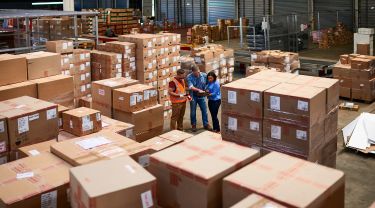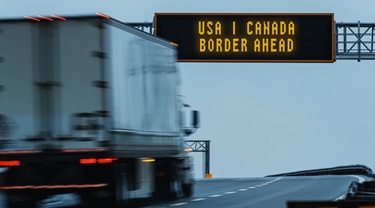Becoming an importer of record (IOR) is a strategy many exporters use. But never has it been more relevant than now, as tariffs continue to complicate the process of selling to the United States.
By understanding the importer of record’s role, while also leveraging Incoterms, you can potentially mitigate tariff-related risks, clarify responsibilities, streamline operations and ensure you’re compliant with trade regulations.
Incoterms are international trade terms that define who’s responsible for shipping, insurance, customs and risk at each stage of a shipment. They clarify buyer and seller responsibilities and define when risk transfers between parties in a transaction. They’re important because when used correctly, they ensure smoother, more predictable transactions, which is especially important when crossing international borders.
What’s an importer of record (IOR)?

The IOR is the person responsible for ensuring imported goods comply with all customs and trade regulations in the receiving country. Although the term suggests it must be the importer, the IOR can be the person shipping the goods, or the person who’s receiving the goods. It can also be an entity.
The IOR plays an important role in customs and tariffs compliance because this person or entity takes on liability, ensures compliance with various regulations and terms of trade agreements and ensures documentation is in order.
“Your records in Canada need to be very clean and transparent, or someone’s going to say, ‘What was in that box?’ which could trigger an audit and an inspection,” says Greg Henderson, co-owner and founder of Exportspark Services Inc., and certified international trade professional and registered Incoterms trainer.
The IOR’s key responsibilities
In addition to ensuring compliance with all import regulations, the IOR:
- Is liable for correcting any issues that come up in the transaction;
- Pays any and all applicable duties (tariffs are a specific type of duty), taxes and other charges;
- Makes sure all documentation is in good order on both sides of the border;
- Maintains a record of transactions;
- Ensures compliance with the customs and border protection body in the country receiving the goods; and
- Ensures compliance with the rules of origin if invoking a free trade agreement and the receiving country’s related regulations (for example, if a good is going to the U.S. and is subject to the Food and Drug Administration’s regulations).
Qualifications of an IOR
As a Canadian business, you can be a non-resident importer to the United States, for example, but you have to register for an importer number and with the U.S. Treasury, so you can pay the applicable tariffs and taxes. This gets more complicated, depending on the type of goods being sold and the rules and regulations governing those products.
“The importer of record plays a lot of different roles, but fundamentally, they become responsible for importing—procedures, processes, certifications and fulfillment as it relates to moving that product into that country,” Henderson says. “It’s a huge benefit to the receiver of goods to have the shipper or seller be fully responsible.”
Henderson says exporters need to decide whether to act as their own importer of record. Ultimately, it comes down to whether you have a good understanding of all aspects of the job. If you decide you don’t, you can also designate a customs broker to act as the IOR in the receiving country.
Carley Mortimer, senior knowledge product manager at EDC, points to a real-world example where a Canadian exporter to the U.S. was the IOR and ended up at a disadvantage.
“After changes in trade policies and regulations this year that affected their product, they were left owing around $45,000 in duties, which can be a significant impact to a company’s cash flow,” Mortimer explains.
“Trade policies can always change and therefore, if you’re not closely monitoring, or remaining aware of, regulations that can affect your product or business when exporting, you could be liable for the financial or legal outcomes as an importer of record,” she says.
When exporting to the U.S., Henderson says it’s important to know your supply chain inside and out. If its origins are within Canada, the U.S. or Mexico, being the importer of record gives you control over the export process, which is tariff-free because of the Canada-U.S.-Mexico Agreement (CUSMA).
In cases where there are tariffs because part of your supply chain isn’t within CUSMA, your product doesn’t fall within the agreement, or it’s subject to the U.S. president’s recent imposition of tariffs, as the importer of record, you can figure out the tariffs that apply and adjust your prices accordingly.
How Incoterms and IOR work together
International commercial terms, also known as Incoterms, are three-letter acronyms that can be used in global sales contracts to clearly state who’s responsible for every step of the transaction. They were created by the International Chamber of Commerce in 1936 to give the business world standard language for invoices, commercial agreements, or legal documents. They have built-in automatic obligations, giving either more or less of the responsibility, obligations and requirements to the seller who’s shipping or the buyer who’s receiving.
“Incoterms were created because there wasn’t really an easy way to explain who pays for shipping, who imports, who exports, other than to write it into a six-page legal document,” Henderson explains.
Mortimer says IOR and Incoterms are tools exporters can leverage in a way that suits them.
“While some exporters may prefer to have more control, or provide their buyers with a streamlined process acting as an importer of record, others may prefer to mitigate their level of risk or exposure to liability,” she says. “Incoterms can be used that benefit the seller the most— (EXW) or buyer (DDP)—or somewhere in between that satisfies both parties level of risk or liability.”
In total, there are 11 Incoterms. Using the right one is important. Here are a couple of the more common terms where the importer of record’s role is critical.
DDP (delivered duty paid): Using this term gives the seller most of the obligations, including all costs for delivery of the goods to the agreed-upon destination and the import and export formalities, fees, duties and taxes. The seller doesn’t have to insure the goods for pre-carriage or main carriage. The buyer assumes no risk or costs until the goods are at their place of business. Note: DDP is the only Incoterm that requires the seller to pay the import clearance and taxes.
FCA (free carrier): The seller is responsible for export clearance and the delivery of goods to the carrier at the agreed-upon destination. The seller pays the cost of pre-shipment inspection, export licences and customs formalities, but it’s the buyer who pays for the import formalities and duties.
EXW (ex works): The seller makes the goods available at their premises. The buyer is responsible for all costs and risks involved in taking the goods from the seller’s premises to their final destination.
Preparing for tariffs as an IOR
The IOR role comes with many responsibilities, but as an exporter, if you take it on, you can mitigate the financial impact of tariffs by ensuring compliance, avoiding penalties and building any additional costs into your price from the beginning.
“While there’s the liability for the Canadian exporter in being the non-resident importer of record, being so could provide a better customer experience for the end buyer, as well as more oversight and control of the goods up to their release,” Mortimer says.
Benefits of Incoterms
- Clearly define your agreement with your buyer
- Can help limit disputes over logistics
- Reduce risks because everything is clearly stated in the Incoterm
- Make tariff preparation more efficient because the Incoterm clearly defines when risk transfers between parties in a transaction
Note: Only one Incoterm can be used in a transaction.
It’s also important to note that there are thresholds known as “de minimis” that are set by the receiving country. Anything under that threshold can be shipped within duties, taxes or the need for a customs broker, explains Alan Dewar, executive vice-president at GHY International, a customs brokerage.
For Canadians exporting to the U.S., for example, the de minimis threshold is $800, so any shipments worth less than that are duty-free. U.S. President Donald Trump removed the de minimis with China and Hong Kong and has suggested doing it with Canada. So far, he hasn’t. Even with de minimis, there are always exceptions, like alcohol in the U.S.
“The de minimis value across different markets can vary significantly, therefore, it’s always important to ensure as an exporter that you know what that value threshold is in the market you’re exporting to—if you’re looking to take advantage of de minimis regulations,” Mortimer says.
For more information on the de minimis differences between markets, see the Global Express Association’s list of 100 countries.
Practical steps to mitigate IOR-related risks
Do your due diligence: To ensure you understand the implications of taking on the liability as an importer of record, educate yourself on the import regulations for your product in the market to which you’re exporting.
Be clear on the documentation needed: Make sure you understand the requirements for proper documentation for the clearance of your goods, as well as the payment of duties and taxes. It’s essential that you maintain meticulous records of import documentation, as well as proof of payment of duties and taxes.
Use Incoterms: Using Incoterms is a good strategy to mitigate risk, provided you use the right one. It’s important to avoid compliance errors by properly defining your IOR responsibilities and one of the best ways to do that is through Incoterms.
Review HS codes: When shipping goods out of Canada, you need to follow specific Harmonized System codes, which are part of a standardized numerical system developed by the World Customs Organization to identify and categorize internationally traded products. They’re regularly updated, Henderson says, so it’s a good idea to double-check Canadian export classifications.
Contact customs: Set up a call with the customs authority in your destination country to review IOR requirements and obligations, or invest in training from a consultant who specializes in importing goods into that country.
Consult an expert: If you feel the maze is too difficult to navigate on your own, engage an expert—a qualified customs broker, for example. “Each scenario is unique, with its own set of pros and cons, so it’s strongly recommended that you consult with a trade compliance expert, customs broker, or legal advisor to assess your specific situation,” Dewar says.
Mortimer agrees: “For Canadian exporters, who aren’t as familiar or well-equipped in this area of international trade, it could be a big undertaking to manage, especially if you’re exporting to multiple markets,” she says. “It’s always highly recommended for exporters to work with a qualified customs broker or trade professional who has the expertise to support.”
Invest in software: If it’s in your budget, there are various software companies with tools tailored to exporters, says Dewar, including tariff origin audit tools, like Canada Tariff Finder, from the Canadian government.
Additional resources
There are lots of tools to educate yourself, including:
- EDC’s tariff preparation webinar
- Our guide to mastering Incoterms and free webinar
- Incoterm training course provided by EDC and the Forum for International Trade Training (FITT)
You should also check out
Expert guidance on how to manage trade regulations, customs requirements and international contracts.






